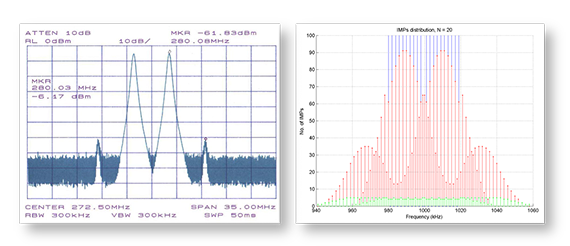What's PIM?
Intermodulation (IM) or intermodulation distortion (IMD) is the amplitude modulation of signals containing two or more different frequencies, caused by nonlinearities in a system. The intermodulation between each frequency component will form additional signals at frequencies that are not just at harmonic frequencies (integer multiples) of either, like harmonic distortion, but also at the sum and difference frequencies of the original frequencies and at multiples of those sum and difference frequencies.

As explained in above section, intermodulation can only occur in non-linear systems. Non-linear systems are generally composed of active components, meaning that the components must be biased with an external power source which is not the input signal (i.e. the active components must be "turned on"). Passive intermodulation (PIM), however, occurs in passive devices (which may include cables, antennas etc.) that are subjected to two or more high power tones. The PIM product is the result of the two (or more) high power tones mixing at device nonlinearities such as junctions of dissimilar metals or metal-oxide junctions, such as loose corroded connectors. The higher the signal amplitudes, the more pronounced the effect of the nonlinearities, and the more prominent the intermodulation that occurs — even though upon initial inspection, the system would appear to be linear and unable to generate intermodulation.

As explained in above section, intermodulation can only occur in non-linear systems. Non-linear systems are generally composed of active components, meaning that the components must be biased with an external power source which is not the input signal (i.e. the active components must be "turned on"). Passive intermodulation (PIM), however, occurs in passive devices (which may include cables, antennas etc.) that are subjected to two or more high power tones. The PIM product is the result of the two (or more) high power tones mixing at device nonlinearities such as junctions of dissimilar metals or metal-oxide junctions, such as loose corroded connectors. The higher the signal amplitudes, the more pronounced the effect of the nonlinearities, and the more prominent the intermodulation that occurs — even though upon initial inspection, the system would appear to be linear and unable to generate intermodulation.
